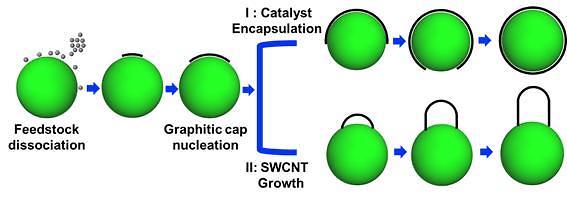
[Courtesy of UNIST]
SEOUL -- Researchers from a state technology institute have come up with a new hypothesis that could solve the secret behind the growth of carbon nanotubes. The theory could boost the research on the carbon material that was invented about 30 years ago.
A carbon nanotube (CNT) is a tube made of carbon with diameters of some nanometers. It has very high tensile strength and is regarded as very valuable source material for high-polymer composite materials that are used for the production of durable products such as bulletproof vests, high-strength fabric, and reinforced metal alloys. However, some researchers claim that the long and thin nanomaterial characteristics of CNTs pose a cancer risk similar to that of asbestos.
While CNT was found to have great conductivity, its position as a conductor material in the electronics sector has fallen behind after graphene, two-dimensional high-polymer carbon allotropy, was found to have a higher conductivity. While researchers use asphalt to extract CNTs, it is easier and cheaper to extract graphene from graphite using simple adhesive tools such as a piece of scotch tape.
The Ulsan National Institute of Science and Technology (UNIST) said that its research team has published an article titled "Why Carbon Nanotubes Grow" in the Journal of the American Chemical Society (JACS) and suggested a hypothesis that could provide answers to unsolved questions about CNTs.
The research team explained how interfacial formation energy affected the growth of CNTs during a production phase called "cap lift-off", a process in which CNTs grow from a catalytic material in tube-shaped structures. If the angle of the tube growth is between 45 degrees and 90 degrees from the surface of the catalyst, the growth of CNT is boosted.
"We were able to identify a phenomenon that was overlooked for the past 30 years through molecular simulation and density functional theoretical analysis," UNIST said, adding that its hypothesis could help accelerate the research of effective designs for the structure of composite catalysts used for CNT production.




![[CES2024] Doosan Group showcases cooperative robots and zero-carbon tech at CES](https://image.ajunews.com/content/image/2024/01/09/20240109141547385883.jpg)